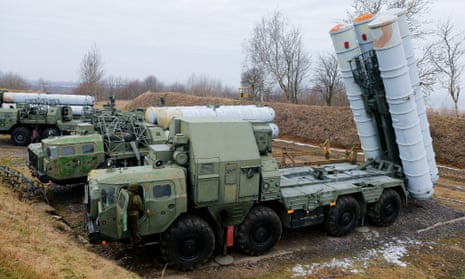Russia has reportedly offered to sell Iran powerful and advanced anti-aircraft missiles in a deal that could have an impact on nuclear talks approaching a deadline next month.
Sergei Chemezov, head of the Russian state arms conglomerate Rostec, was quoted by the Tass news agency as saying the firm was willing to supply Tehran with Antey-2500 missiles with the capability of intercepting and destroying ballistic and cruise missiles as well as aircraft. Chemezov said Tehran was considering the offer.
If the sale goes ahead, the missiles are likely to represent a significant defence against any future air strikes aimed at Iran’s nuclear facilities, and so could in theory diminish pressure on Iran to come to an agreement in nuclear negotiations.
Conversely, if the talks fail, a missile deal could raise pressure from Israel and from US hawks for military action before the delivery of the Russian weapons makes air strikes riskier and less effective.
Israel’s prime minister, Binyamin Netanyahu, is due to deliver an address to the US Congress next week in which he is expected to urge the administration to take a tougher line against Iran.
The planned sale of a less sophisticated and shorter-range surface-to-air missile system, the S-300, was cancelled in 2010 after concerted Israeli and US pressure on Moscow. But since then Vladimir Putin has returned to the presidency in place of the more conciliatory Dmitry Medvedev, Moscow’s relations with the west have dramatically worsened over the Ukraine conflict, and the sharp drop in the oil price together with western sanctions have left Moscow increasingly desperate to find new sources of foreign currency. Russian arms sales last year generated $13bn (£8.4bn).
“As far as Iran is concerned, we offered Antey-2500 instead of S-300. They are thinking. No decision has been made yet,” Chemezov said, according to Tass. “I don’t conceal it, and everyone understands this, the more conflicts there are, the more they buy off weapon from us. Volumes are continuing to grow despite sanctions. Mainly, it’s Latin America and the Middle East.”
In Geneva on Monday, nuclear talks adjourned after the latest in a long series of meetings between the US secretary of state, John Kerry, and his Iranian counterpart, Mohammad Javad Zarif.
The negotiations are aimed at finding a formula by which Iran accepts curbs on its nuclear programme – particularly uranium enrichment – for a certain number of years, in return for sanctions relief. Kerry and Zarif were joined in Geneva for the first time by the head of the Iranian atomic energy organisation, Ali Akbar Salehi, and the US energy secretary, Ernest Moniz, in a development which negotiators described as necessary to confront the complex technical issues at the heart of the talks. Hossein Fereydoun, the brother of Iran’s president, Hassan Rouhani, also took part in the latest discussions.
Diplomats from US and Iran, as well as the other parties to the talks – UK, France, Germany, Russia and China – are due to reconvene in Switzerland next week in an attempt to reach a framework agreement before a deadline of late March. They have until the end of June to fill in all the details of what would be a complex but historic accord.
US and Iranian negotiators characterised the Geneva talks as constructive, with progress made but still a long way to go.
Ali Vaez, senior Iran analyst at the International Crisis Group, said: “It appears that the final touches to a mutually acceptable formula for curtailing Iran’s enrichment capacity were added by Iranian and American nuclear chiefs. What remains is a similar solution for untangling the intricate spider web of sanctions.”
The proposed missile sale appears to have been discussed by the Russian defence minister, General Sergey Shoigu, when he visited Tehran last month. The two countries have been in dispute since the cancellation of the S-300 delivery five years ago. The Antey-2500 is an improved version of the S-300 with a longer range and enhanced capabilities.
Nato labels the system as the SA-23 Gladiator. It is a mobile system, launched from tracked vehicles complete with radar and command post. It can launch a variety of anti-ballistic missiles, depending on the nature of the target it has to intercept. Its Russian maker claims it can stop not only missiles and fixed-wing aircraft but also drones and precision-guided bombs. Russia has sold the same system to China, Vietnam and Cyprus.

Comments (…)
Sign in or create your Guardian account to join the discussion